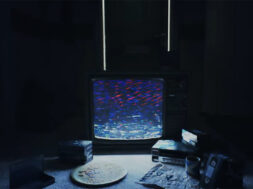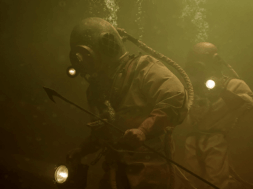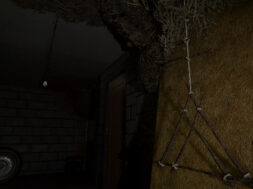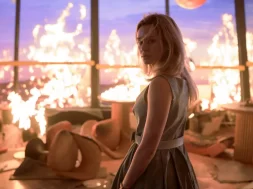Based on the Hit Film is a series of articles looking at the video game spin-offs and adaptations of popular horror and genre movies.
The Slasher Flick is one of my favorite sub-genres in film, having provided me with countless hours of intense thrills and occasional laughs since I was a budding teenager. Clearly, I’m not alone in loving these movies, as Slashers used to dominate the worldwide box-office, much to the chagrin of some of the snootier film critics out there. With all that popularity back in the day, it was only a matter of time before these horrific stories of masked maniacs and elaborate executions would make their way over to other media.
So today, I’d like to discuss the weird world of Slashers in gaming! Only this time, it won’t be about the obvious influences that the genre had on horror titles like Clock Tower or Splatterhouse, but we’ll instead be focusing on officially licensed adaptations of some of the biggest Slasher franchises out there.
Funnily enough, our journey begins in the early 80s, during the beginning of the Videogame Crash that nearly killed the industry. The Atari 2600 had popularized the idea of selling individual games on external cartridges, but a surplus of low-quality titles had flooded the market (many of them licensed adaptations like the infamous E.T.), leading many consumers to believe that this was the end of the video game as we knew them.
Nevertheless, Atari soldiered on, and many readers will be surprised to learn that the 2600 actually had more than a handful of horror offerings, with games like Frankenstein’s Monster and Haunted House becoming some of the console’s most sought-after titles. Thus, it was only natural that some developer out there thought that it was a good idea to bring cinematic hits like The Texas Chainsaw Massacre to pixelized screens everywhere.

Not exactly cutting-edge, eh?
Instead of putting players in the shoes of an ill-fated scream-queen, however, VSS Inc’s 1983 adaptation of Hooper’s ground-breaking film actually let players go on a gas-powered rampage through the Lone Star State, murdering hopeless victims in order to rack up a high score before fuel runs out. There wasn’t much variety to the game, and it wasn’t much to look at either, but as a novelty arcade-like experience, there were certainly worse experiences out there.
Of course, this being the 80s, the release of the game resulted in a backlash of angry parents and institutions criticizing the title for its “explicit” nature and apparent glorification of violence through the use of a high-score. Unfortunately, this meant that several stores simply refused to stock the game, leading to poor sales and a certain notoriety among gamers. However, this didn’t stop Wizard Video from attempting to translate yet another 70s horror classic into an interactive experience later that same year!
This time, they would be borrowing from John Carpenter with a new take on his iconic Halloween. Despite insisting on another slasher adaptation, Wizard Games seems to have taken some of their previous horror title’s criticism to heart, as this time players would be put in the shoes of a babysitter attempting to escape from a maniacal murderer as she rescues an assortment of pixelated children. While it was an official Halloween tie-in, the characters featured in-game were left nameless (and the Atari 2600’s graphics really didn’t help in representing real-world likenesses), so the only thing that truly tied this title to the film was the surprisingly effective use of Carpenter’s iconic score during chase sequences.
Even with a bigger emphasis on survival and a respectable protagonist (hell, you’re trying to save the children this time around, not gore them with a chainsaw), the game suffered the same complaints and poor sales as Wizard’s previous title, eventually leading to the company’s bankruptcy. Again, this wasn’t a particularly astonishing game, but the action was intense, the soundtrack was awesome and it’s pretty clear that this title laid the groundwork for the future of survival-horror. There were even 8-bit gore effects on display here, making the game way more violent than the movie!
In any case, just a few years later yet another iconic masked murderer would make his way over to the world of gaming through the release of Domark’s Friday the 13th on the Commodore 64. In the game, an assortment of teenagers embark on a perilous journey through Camp Crystal Lake as they attempt to save their friends from an inexplicably-shapeshifting Jason Voorhees.

At least the kills feel like they come straight from the movies.
While the C64 was a step above the Atari 2600 in terms of processing power, the graphics here still made it hard to capture the look and feel of the F13 franchise (Jason is barely recognizable even after he stops disguising himself as one of your fellow counselors), and the gameplay was kind of stunted as the levels often shifted perspectives during exploration. However, there are some exceptionally gory splash screens whenever a murder takes place, and the overall janky-ness can often be endearing.
Jason wasn’t the only slasher making a killing on personal computers, however, as Freddy Krueger would eventually get his own game in 1989 with Westwood Studios’ A Nightmare on Elm Street for C64 and DOS. The game, based on the ever-popular Dream Warriors, allowed players to select one of the film’s characters and explore Freddy’s home in the Dream World while fighting off nightmarish creatures and, eventually, the Dream Master himself. Out of all the games so far, this one best represents the franchise that it’s adapting, with spooky dreamlike environments and a recognizable depiction of Freddy, though it still has its fair share of kinks.
That same year, the infamous LJN company would essentially remake both titles for the Nintendo Entertainment System, attempting to cash in on the franchises’ continued success.
The new version of Friday the 13th featured enhanced graphics (Jason actually looks like himself in this one, except he’s purple), and “smoother” gameplay, but also axed the gore and included random zombies in an even more confusing rendition of Camp Crystal Lake. While it often ranks high among “worst-of-all-time” lists, you have to admit that there is a certain charm to the game once you get the hang of it, and there’s a reason why the purple-NES-style Jason is still considered a classic look by fans of the franchise.
Freddy’s makeover was even less successful, though, with the original exploration-heavy title being transformed into a poor man’s Castlevania. The graphics may have been improved, but everything else became a frustrating, side-scrolling slog. Curiously, the game was originally pitched as another murder-simulator, with players taking control of Freddy himself, but the controversy surrounding Wizard Games earlier that decade almost certainly convinced the developers to take the game in a much duller direction.

Still pretty intimidating, though!
After these LJN releases, there would be a huge gap in the development of officially licensed Slasher games. We’d see a few weird projects here and there, mostly mobile games like The Texas Chainsaw Massacre (a tie-in for the 2003 remake and its prequel) and Chucky: Slash and Dash, but we went through several decades without a true Slasher on either consoles or PC. That’s not to say that the genre wouldn’t continue to influence titles like Deadly Premonition or Haunting Ground, but it would only be with 2009’s Saw: The Videogame that a Slasher would legitimately return to gaming (though I guess that depends on whether or not you consider Saw a Slasher franchise).
Developed by Zombie Studios, Saw was a surprisingly entertaining game with input from series creators James Wan and Leigh Whannel. This time, players would take control of Detective David Tapp as he traverses a booby-trapped asylum after having been kidnapped by Jigsaw. The game is especially faithful to the films, featuring several iconic traps and characters (though only Tobin Bell reprises his role), though the third-person combat feels a bit off.
Saw was actually popular enough to warrant a sequel, Saw II: Flesh & Blood, though that title was rushed in order to coincide with the release of Saw 3D in 2010, resulting in middling reviews and sales. Konami (the game’s publisher) had previously expressed interest in turning the Saw games into a spiritual successor to their own iconic Silent Hill franchise, but Flesh & Blood‘s failure seemed to kill off that idea.
It would only be with recent projects like 2017’s Friday the 13th and Dead By Daylight‘s DLC characters (featuring everyone from Ghostface to Ash Williams) that slashers would make another appearance in the gaming industry, though these are almost entirely relegated to unique characters in online games and the occasional fighter.
Even so, these recent horror titles (not to mention other licensed releases like Alien: Isolation) have proven that there are passionate developers out there willing to take established franchises seriously, rescuing licensed games from the bargain-bin status of yesteryear and making them extremely popular again. I’d love to see that passion bloom into a new generation of Slasher games, but we’ll have to wait and see what the future holds for these titans of terror, especially when so many of these franchises seem to have gone dormant over the years.
All we know for sure is that you can’t keep a good Slasher down, so it’s only a matter of time before these killers rise again in interactive form!









